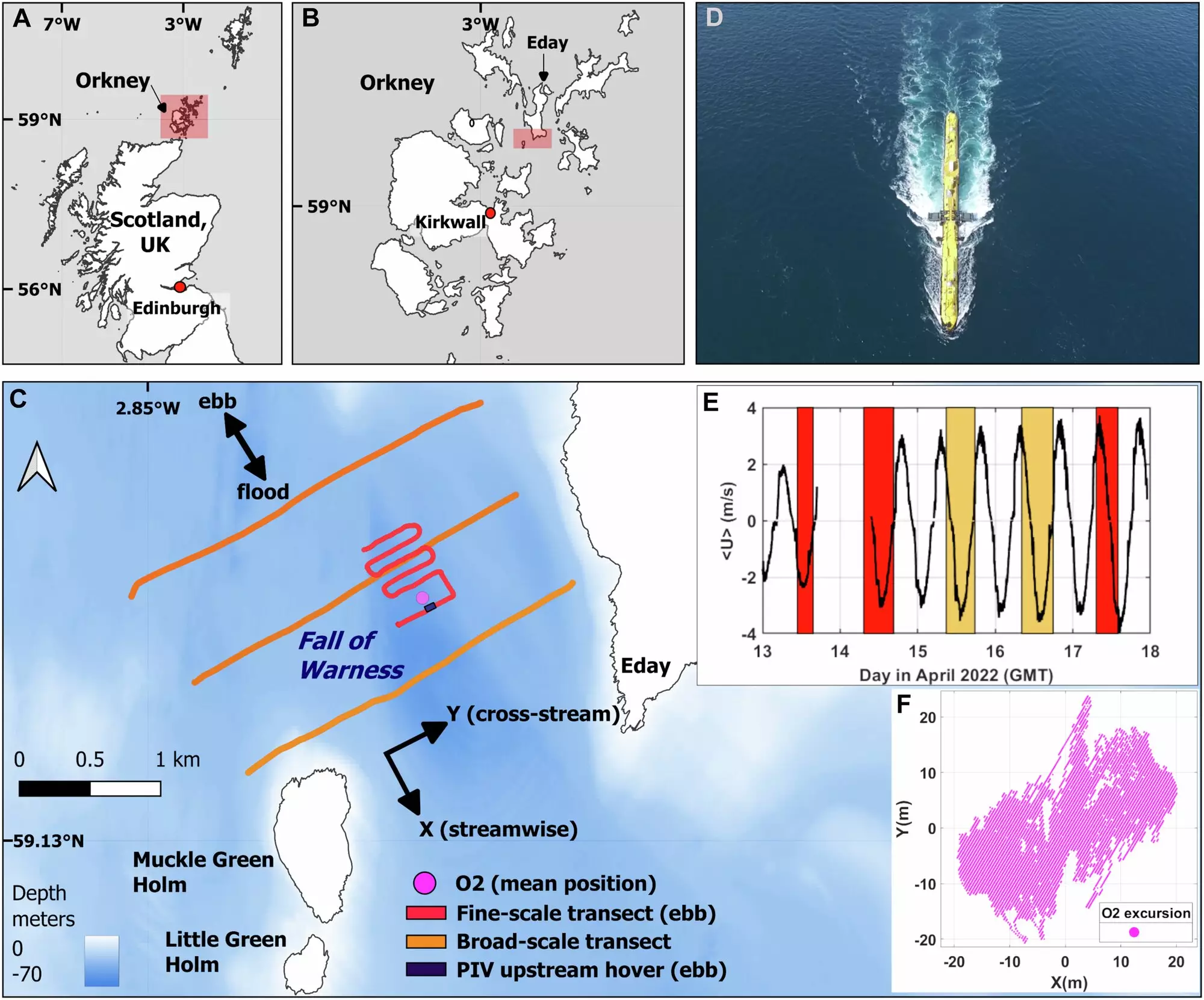As the demand for sustainable energy sources continues to escalate, tidal power has emerged as a frontrunner among renewable energy alternatives. Emerging technologically advanced tidal installations are expected to proliferate along the UK’s captivating coastline in the upcoming decades. However, the transition to a tidal energy future is not devoid of hurdles; the unique conditions of turbulent seas pose significant obstacles. Addressing these challenges, a team of dedicated scientists has launched an innovative research initiative focused on Orbital Marine Power’s O2 tidal turbine, aimed at better understanding the dynamic behaviour of tidal currents and their ecological implications.
Located in the Orkney Islands, Scotland, the O2 tidal turbine represents a significant shift in conventional thinking about tidal energy. Unlike traditional underwater turbines that are fixed to the seabed, the O2 is designed to float on the surface, secured by mooring lines that anchor it to the ocean floor. Spanning over 70 meters in length, the turbine is not only a marvel of engineering but also possesses the potential to supply electricity to about 2,000 homes in the UK annually, thus significantly contributing to energy sustainability. However, its impressive potential is coupled with complex challenges, particularly due to the swift tidal flows—some exceeding 8 knots—that characterize this marine environment.
This ambitious study employed a dual approach combining aerial drones and boat-based surveys, enabling scientists to adeptly model the intricate tidal flows around the O2 turbine. By capturing real-time data, researchers aimed to uncover how the massive turbine interacts with unpredictable ocean currents and the surrounding marine ecology. Dr. Lilian Lieber, a senior research fellow involved in the study, noted the exhilaration and challenges of conducting oceanographic surveys in such powerful tidal streams. Through their research, scientists could identify potentially damaging turbulence and assess how the wake generated by the O2 might influence not only the device’s functioning but also the strategic positioning of future tidal turbines and the health of local marine habitats.
One significant contribution of this study was highlighting the ecological implications of tidal turbine installations. Previous research indicated that the wake produced by tidal turbines could create beneficial foraging hotspots for seabirds, yet there lies a delicate balance. If turbine arrays are clustered too tightly, it may restrict marine fauna movement, presenting a nuanced problem for marine biodiversity. During the drone surveys, the researchers even encountered orcas, illustrating that understanding and mitigating the impact of these turbines on marine life is a critical consideration in the ongoing development of tidal power infrastructures.
Beyond its ecological impact, tidal energy is projected to fulfill a significant portion of the UK’s electricity needs. Estimates suggest that tidal stream energy could meet approximately 11% of annual electricity demand, positioning it as a reliable and consistent source of renewable power. This predictability stems from tidal movements, which, unlike wind or wave energy, exhibit regular cycles. Although the sea’s density is over 800 times that of air, making tidal systems more efficient than their wind counterparts, scaling up technology and establishing robust grid connections in dynamic marine environments remain substantial challenges.
The research conducted collaboratively by the Marine Biological Association (MBA), the University of Plymouth, and the University of the Highlands and Islands (UHI) Shetland exemplifies how scientific expertise merged with advanced technology can lead to meaningful progress. It offers valuable insights for local industries and communities potentially impacted by marine renewables, especially in the Highlands and Islands region. Senior Scientist Shaun Fraser emphasized that the study highlights the importance of using modern methodologies to gain a deeper understanding of the dynamic environments where tidal energy systems will be deployed.
As the tides of change bring forth innovations in renewable energy, it is essential to confront the multifaceted challenges associated with tidal power. This pioneering study emphasizes the necessity of merging empirical research with sophisticated measurement techniques, allowing for nuanced assessments of environmental conditions. Understanding tidal dynamics is not merely a technical query but a fundamental necessity to ensure sustainable marine energy development. The integration of real-world environmental data into planning and execution will be paramount as the UK charts its course towards a greener, electricity-driven future. The lessons learned from the O2 tidal turbine may well represent the key to unlocking the full potential of tidal energy in the years to come.

